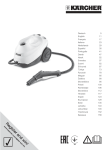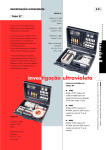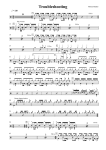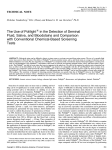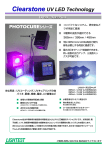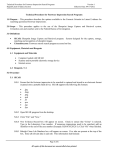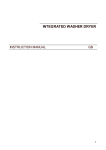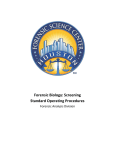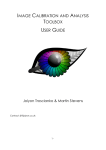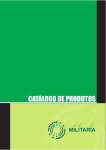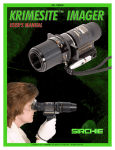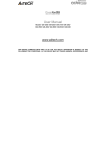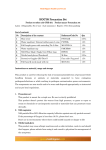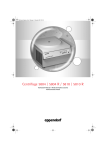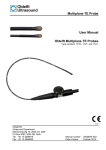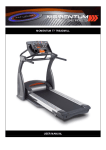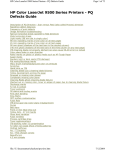Download volume 63, issue 1
Transcript
Technical Note Forensic Reflected Ultraviolet Imaging Austin Richards 1 Rachel Leintz 2 Abstract: The use of ref lected ultraviolet (UV) imaging has long been documented in the forensic literature, but little has been written about the “how” and “why” elements of using this technique in the field. This paper examines the different types of UV light and explains how and when to use different imaging techniques to visualize hidden evidence. The authors explain, in detail, the wavelength of light required, the image capturing equipment, and the type of evidence that can be examined using these techniques. Introduction The technique of ref lected ultraviolet (UV) photography has been around for more than 100 years. During that time, some interesting applications have been developed for it–particularly in the field of forensics. In some instances, ref lected UV imaging is the only way to visualize certain phenomena, such as faint traces of substances on surfaces or the surface texture on certain transparent materials [1]. These characteristics of ref lected UV imaging would seem to make it a required part of forensic investigation, but its use has been inconsistent over the years. There are two reasons for this. First, it is hard to get good results with f ilm-based ref lected UV photographic methods without a lot of trial and error because of the difficulties involved with determining correct exposure, achieving the appropriate application angle for the ultraviolet light source without a live UV image preview, and setting the focus and field 1 2 Oculus Photonics, Santa Barbara, CA Phoenix Police Department, Crime Scene Response Unit, Phoenix, AZ Received Febr uary 3, 2012; accepted June 21, 2012 Journal of Forensic Identification 46 / 63 (1), 2013 of view properly. Second, as police departments worldwide have migrated to digital photographic equipment, they have discovered that the standard digital cameras they have purchased do not respond to ultraviolet light well at all [1, 2]. Even a special line of Fuji digital cameras that were converted to be more responsive in the UV and infrared (IR) wavebands did not have much sensitivity in the UV waveband. This is because of their Bayer color filter arrays that made it possible to shoot color images but also tended to block UV light and because silicon sensors were more responsive to infrared light than to UV light. There was also additional blocking of UV light from the optics. The camera systems were sold with a standard Nikon lens that was not ideal for UV imaging. This is due to the antiref lection coating on the lens as well as absorption characteristics of the optical glass. This made the transmission less effective in the UV band than if the lens were designed for UV work and built out of the best UV optical materials. But the worst part was that these cameras were sold as part of forensic camera packages with a UV bandpass filter that unfortunately passed a substantial amount of infrared (IR) light as well. When forensic photographers attempted to record ref lected UV images, they invariably recorded an almost purely IR image. This is because the camera is much more responsive to IR light than it is to UV light, and because common photographic light sources contain very little UV light. Some forensic photographers assumed that the camera just did not work correctly in the UV waveband, because the resulting images looked nothing like UV images they had previously taken with film. The user’s manual and other documentation provided by Fuji did not shed any light on the matter. Other photographers incorrectly assumed that the images they were capturing were UV, when the images they obtained were really IR. A number of incorrectly designated images were published in the forensic literature, which further added to the confusion, because IR images of common scenes generally look nothing like their UV counterparts. One of the primary motivations of this paper is to describe how to take UV digital images correctly, using the right equipment, in the hopes that forensic photographers will buy the equipment they need and start using the technique again. After all, if one follows the correct procedure, it is much easier, faster, and less expensive than UV film photography ever was. This may lead to a resurgence of these techniques, which are also made easier and more powerful than ever by the recent developJournal of Forensic Identification 63 (1), 2013 \ 47 ment of extremely bright near-UV light sources based on light emitting diodes. These lights are much more intense than traditional light sources that are based on gas-discharge tubes and have a number of other advantages as well. Light Theory Explained U lt r av iole t r a d iat ion i s ch a r a c t e r i z e d a s l ig ht w it h wavelengths between 10 nm and 400 nm. For the purposes of forensic work, there are two ranges of wavelength (wavebands) that are of interest: the near-UV band (300 to 400 nm) and the shortwave UV band (200 to 300 nm). These two wavebands, which we will refer to as NUV and SWUV, respectively, are very useful because they allow the user to visualize evidence that is usually difficult or impossible to record with other photographic techniques. (In the forensic community, near-UV radiation is also called longwave UV. The authors prefer calling it near-UV, because the band is right next to the visible spectrum of light.) For reference, the infrared light detected by silicon sensors used in forensic cameras is in the near-infrared (NIR) band, with a wavelength range of 750 to 1100 nm. There are many interesting forensic applications for this band, and these applications will be discussed by the authors in a future article. The strong absorption of UV radiation by many substances makes it possible to image forensic evidence that is not readily apparent to the unaided eye [1, 2]. Ref lected UV photographs can often reveal otherwise invisible traces of material on a given surface if those materials absorb UV, which is a common characteristic for many materials, particularly organics. UV imaging can be used to see substances that are translucent or transparent to the unaided eye and to NIR imaging systems. Because of the strong absorption of UV radiation, normally transparent material, such as very faint blood stains, will have opacity, enabling visualization of a bloody shoeprint, for example. The rule of thumb for using ref lected UV techniques is this: If the unaided eye can only see a faint pattern of some substance on a surface, the chances are very good that the pattern will “pop” and show with a much higher contrast when imaged in the near-UV band. If one uses shortwave UV imaging, the chances are even better of getting a good record of the pattern. In general, organic materials will be even better absorbers of SWUV radiation than NUV. However, a caveat for the forensic photographer needs to be given when considering the use of SWUV for imaging purposes. SWUV is often used in germicidal lamps and is also Journal of Forensic Identification 48 / 63 (1), 2013 commonly used to “clean” DNA work stations. This is because this particular wavelength is capable of destroying DNA [3]. If an investigator plans to collect DNA samples from a photographic subject, he or she needs to be aware that potential DNA profiles could be destroyed by using SWUV imaging. This is generally not the case with NUV imaging, unless the NUV exposure is quite prolonged and intense. The longer wavelengths of NUV radiation have less energetic photons that are not as likely to damage DNA. Some applications for UV imaging include: 1. Imaging bite marks and other patter n injuries to skin by increasing the contrast of the surface impressions or by visualizing the faint darkening of the skin that appears over time in response to pressure trauma (NUV) [2]. 2. Imaging shoeprints, footprints, and handprints made with substances that are transparent to the eye and near-IR imaging, such as faint bloodstains or faint dust (NUV and SWUV). 3. Searching for and documenting bone fragments (NUV). 4. Imaging latent fingerprints (SWUV). 5. Imaging explosives residue on surfaces (NUV and SWUV). This paper will cover the first two applications. The latter three will be covered in a future paper by the authors. Figures 1 through 4 are images of partial bloody fingerprints taken in different wavebands of light. Journal of Forensic Identification 63 (1), 2013 \ 49 Figure 1 Visible light image of partial bloody prints. Figure 2 Near-IR image of bloody prints. The lighting is an incandescent source, and the PECA 910 filter from the forensic kit built around the Fuji IS Pro was used. The blood is quite transparent in this band. Even the inked letters denoting A and B are transparent. This is not a good method for partially patent fingerprint examination. Journal of Forensic Identification 50 / 63 (1), 2013 Figure 3 Near-UV image of bloody prints. This image was taken with an IS/Pro, a 365 nm LED illumination source, and a Baader Venus filter. The prints are definitely easier to see than in the visible image. Figure 4 Shortwave UV image of bloody prints. The illumination source is 254 nm from a low-pressure mercury lamp. The image was taken with a special SWUV camera. Journal of Forensic Identification 63 (1), 2013 \ 51 Procedures and Equipment for Photography Near-UV and Shortwave UV Imaging: How Do You Do It? Photography using ref lected NUV radiation is essentially the same as visible-light photography. Digital sensors can be made reasonably sensitive to NUV and can be used with suitable optics, filters, and illumination to take photographs. But most digital cameras are designed with NUV blocking filters that are not easily removable. Attempts to record N U V images with these cameras usually yield disappointing results. Some specially modified digital single-lens ref lex cameras (DSLRs) can be used for NUV photography. Silicon sensors in DSLRs are wide spectrum and have to be used with bandpass filters to record NUV unless the lighting is pure NUV, with little or no visible or IR light present. Many forensic photographers have tried using their traditional UV pass filters (e.g., Kodak Wratten 18A) on their digital cameras. Because the Wratten 18A has a substantial transmission peak in the IR band, the resulting image is often more of a near-IR image than anything else. Fortunately, there is at least one filter on the market that solves this problem: the Baader Venus f ilter (Baader Planetarium, Mammendorf, Germany), which we will describe in more detail shortly. Shortwave UV imaging requires special types of detectors. The RUVIS systems use an image intensifier with a photocathode that is responsive to shortwave UV light. There are also silicon CCD sensors that can be processed in a special way to make them sensitive in the SWUV band. This CCD technique was used to take the SWUV images in this article. NUV Camera Systems At the time that this article was written, there was a fairly limited selection of equipment that was optimal for NUV photography with a DSLR. These were the best options: 1. Fuji S-3 UVIR or Fuji IS Pro camera or other aftermarket DSLR conversion with NUV response (such as those done by LDP LLC., Carlstadt, NJ). 2. JENOPTIK Coastal Optics 60 mm UV-VIS-IR lens or 105 mm UV lens, Universe Kogaku 78 mm lens with F-mount adapter, or legacy Nikon U V-Nik kor 105 mm lens. In a pinch, a conventional Nikon F-mount lens should work, though it will have reduced NUV transmission. Journal of Forensic Identification 52 / 63 (1), 2013 3. Baader Venus filter with 52 to 48 mm stepper ring 4. NUV illumination source (LED-based illuminator, gasdischarge blacklight, or direct sunlight) The Fuji S-3 UVIR and the Fuji IS Pro DSLRs were marketed for forensic work. Their “hot mirrors” have been removed so that NIR and NUV light can reach the sensor. The end result is a camera that has reasonable response to NIR light and substantially less response in the NUV band. Still, the NUV response is enough to make the cameras capable of NUV imaging, as long as one achieves sufficient exposure, either through bright NUV lighting or long exposure times. Cameras with hot mirrors typically have negligible NIR or NUV response1. Invisible-light images should be presented in black and white, and ideally, all the pixels in any camera used for UV imaging should be monochrome. Unfortunately, the Fuji cameras are like every other DSLR on the market and have a color filter array on the sensor. There are three colors of filters–red, blue, and green– and each has a distinctive spectral response in the NUV band. Because of this, NUV images taken using direct sunlight as an illumination source will have a different color cast to them than images taken by the light of a narrowband NUV illuminator. After much experimentation, we recommend setting the camera to shoot in black and white mode. This is a setting within the Fuji’s menus that will combine the R, G, and B channels in such a way as to produce grey-level pixel values with no color. This technique will exploit all the available pixels in the sensor in the final image. Nikon made a 105 mm lens for 35 mm cameras called the UV-Nikkor, but it is long out of production. JENOPTIK Coastal Optics (formerly Coastal Optics) has designed a replacement for this lens, with improvements. Their 60 mm CoastalOpt lens is designed to have visible, NUV, and NIR transmission and color correction. They also make a clone of the 105 mm UV-Nikkor lens that works down into the SWUV band. These lenses are expensive but of high quality. A more economical option is the 1 The hot mirror is specifically designed to keep out near-IR light, which will substantially degrade digital photos. Unlike color film, which has very little near-IR response, silicon sensors have plenty of response in that range. Because most scenes are lit with light sources that contain enough nearIR light, and that light transmits reasonably well through most lenses, it must be stopped before the sensor. The hot mirror is really an optical coating applied to the sensor window. It is designed to eliminate near-UV light, another unwanted waveband of light that gets through lenses well enough to soften images or throw off color balance. Journal of Forensic Identification 63 (1), 2013 \ 53 78 mm Universe Kogaku quartz lens. The elements include fused silica, which is often incorrectly called quartz, a lower purity mineral for m. Fused silica transmits below the glass cutoff wavelength of 310 nm. The authors have found that it is not strictly necessary to use an expensive fused silica lens for NUV work, because standard BK7 lens glass has some transmission at 365 nm and below. We have used standard Nikon lenses on the Fuji S-3 UVIR with reasonable results. Compared to the Coastal Optics lenses or the UV-Nikkor, the transmission and color correction of standard lenses is mediocre in the NUV band. Fused silica lenses are mandatory for shortwave UV imaging, because absolutely no radiation below about 300 nm band passes through glass lenses–it is all absorbed. It is often convenient to search for evidence in the NUV band using an N U V viewer. The Fuji cameras can be used in this fashion, but with limited utility. Both cameras can be commanded to retract the mirror and generate a live video image. When a Baader filter is in place, and sufficient NUV illumination is present, the user will see live NUV video on the rear LCD screen. But this live video uses up the batteries rapidly, and the user has to keep pressing the button every 30 seconds to restart the live preview. It is also hard to see the viewfinder image in the presence of ambient lighting without a loupe on the LCD screen. A useful tool for a quick search of a scene in the NUV band is the Oculus Photonics UVScanner (Figure 5). This is a battery powered, handheld viewer with excellent spectral purity and a built-in pair of NUV illuminators. This unit has rubber eyecups on the back to block out ambient light. The operator sees an NUV video image on the dual LCD displays and can then walk around looking for evidence at a scene while using stick-on evidence markers to mark it for later photography at high resolution with an NUV DSLR system. Journal of Forensic Identification 54 / 63 (1), 2013 Figure 5 Oculus Photonics UVScanner. This device images in the near-UV band, from about 320 nm to 440 nm, with a peak response at 370 nm. Journal of Forensic Identification 63 (1), 2013 \ 55 NUV Filters The Baader Venus filter was developed in Germany for use on telescopes to image the NUV-absorbing clouds of the planet Venus. It is a perfect filter to use for NUV imaging with the Fuji cameras, because it has high transmission in the 330 to 380 nm band and virtually no transmission in both the visible and near-IR bands (Figure 6). This stands in stark contrast to other filters (e.g., Wratten 18A, PECA 900) that suffer from large red leaks and are generally unsuitable for use with a DSLR for NUV imaging (Figure 7) [1]. The Baader Venus filter makes it possible to photograph scenes illuminated by direct sunlight and get very pure NUV images. The excellent rejection of out-of-band radiation makes it possible to use this filter in an indoor situation even with substantial ambient incandescent illumination. The filter has a 48 mm ring thread on it, which requires a 52 to 48 mm stepper ring to allow it to be screwed onto the front of the Coastal Optics lens or UV Nikkor. Figure 8 depicts the necessary components for a complete NUV photography kit. Figure 6 The 2-inch Baader Venus filter transmission curve. Note the change in scale. Beyond 418 nm, the magenta transmission data points have their transmission values multiplied by a scaling factor of 1000. The red leak at 950 nm is thus roughly 10,000 times smaller than the near-UV main peak and is therefore completely negligible. Journal of Forensic Identification 56 / 63 (1), 2013 Figure 7 The PECA 900 filter, which is virtually identical to the now unavailable Wratten 18A filter. Note the large red leak, which is almost 12% the height of the NUV peak. For a sensor with a lot more NIR response relative to NUV response, this filter will heavily bias the image towards the NIR, unless there is a very large amount of NUV light present relative to NIR. Unfortunately, this filter was part of a forensic package sold by Fujifilms with the S-3 UVIR and IS Pro packages. Many other NUV filters designed for film have the same red-leak issue. Figure 8 NUV digital imaging system. Fuji IS Pro, Universe Kogaku quartz lens with Nikon F-mount adapter, 2-inch Baader Venus filter, and adapter ring. Journal of Forensic Identification 63 (1), 2013 \ 57 NUV Illumination Having a sufficient level of near-UV lighting is crucial, and here again, specialized equipment should be used. Without fairly bright NUV light sources, photos will tend to be dramatically underexposed for two reasons: NUV is scarce in indoor or nighttime environments, and most materials appear very dark in the NUV band because of their high absorption. Trying to use conventional indoor lighting for NUV illumination is doomed to failure–there is little or no NUV emitted by these lights by design (to prevent furniture and paint from fading). Even with a filter like the Baader with its tiny red leak, the exposures have to be so long that the dark noise of the CCD sensor in the Fuji cameras becomes the dominant feature in the image. Several ALS units (including the Rof in Polilight) have “UV” settings, but we have found that these are not nearly bright enough for digital NUV photography without very long exposures of relatively small areas of the scene. There are also special f lash units that are designed to emit more NUV light than typical f lashes. These f lashes have strobe tubes that do not have a UV-absorbing coating on them. We have found the QFlash brand unit to be relatively weak in the NUV band, and multiple f lashes of the unit were required to get a decent exposure for typical conditions. This, of course, requires that the camera be mounted on a tripod. An additional complication to using a f lash for near-UV photography is that the NUV light is not present in the scene until the f lash is actually fired. This makes it impossible to focus the image using the live-preview function of the camera. Because the Baader filter does not transmit any visible light, the user must take a picture, look at the results on the camera’s LCD screen, then adjust the focus blindly and take another picture. This is very time consuming and will quickly use up the batteries in the f lash unit and camera. The photographer can, in principal, take off the Baader filter, adjust focus using visible light, replace the filter, and shoot images using the f lash. In practice, this does not work well, because all but very expensive UV lenses will have a different focus setting for visible light and near-UV radiation. The authors have had excellent results with NUV lighting from Clearstone Technologies in Minnesota. They manufacture illumination systems composed of arrays of very bright LEDs at a wavelength of 365 nm and others. The 365 nm wavelength is no accident–it corresponds to a strong line of high-pressure mercury vapor discharge lamps that the LEDs are intended to Journal of Forensic Identification 58 / 63 (1), 2013 displace in the commercial market. There is a large body of filmbased NUV photography in this band, so it is a good starting point for any digital NUV imaging. The NUV LED lighting systems from Clearstone Technologies are very spectrally pure, having almost all their radiation within a very narrow waveband–about 10 nm wide in the case of the 365 nm system. These systems can f lood a crime scene with intense NUV radiation–far more than is available from even direct sunlight. This high intensity makes for excellent exposures even with shutter speeds of 1/60 second or faster that handheld photography often requires. An excellent lighting head for forensic applications is the JL3-365E-42. This unit puts out 10.5 watts of 365 nm light and it can be driven by the Clearstone CF2000 lighting controller. Because the Clearstone light is so spectrally pure, it is possible to do NUV photography without the use of the Baader filter. The authors think that this is inadvisable because often there may be visible f luorescence in the scene that will record and spoil the spectral purity of the resulting image. Any visible or IR ambient light must be eliminated or at least greatly reduced to make this technique work well. Figure 9 shows a photo of a Clearstone NUV light source being used to light a wood f looring panel with 365 nm radiation. Figure 9 Clearstone lighting system used on wood flooring for oblique 365 nm imaging. Journal of Forensic Identification 63 (1), 2013 \ 59 A much less expensive (but much less effective) alternative to the Clearstone system is an array of blacklights like the ones sold at hardware stores. These lamps are sold as 18-inch or 48-inch f luorescent tubes with dark purple glass envelopes. Like the Clearstone, these lamps radiate around 365 nm, but they are much less intense than LED-based solutions. We have found it necessary to arrange six or eight lamps in banks of lighting fixtures within 18 inches of the subject to get usable illumination levels. Because the tubes are bulky and long, it is not possible to get an intense spotlight of near-UV light out of them. Even at these close ranges, exposures of multiple seconds are necessary to achieve adequate illumination, so a tripod is required. 2 A third option is a Crime-Lite 82S UV lighting system by Foster and Freeman. This is a battery-powered handheld NUV source in a convenient form factor. We do not have data on the total power emitted by the illuminator, but it is less than the Clearstone system. Nevertheless, this forensic light source is quite suitable for the imaging of smaller regions of interest at a crime scene. There are several other handheld near-UV f lashlights on the market, including products made by Rof in and Labino, that emit on the order of a few watts of NUV radiation power. These are based on LED emitters, and thus are ver y spectrally pure–perfect for ref lected-UV photography. It should be mentioned that the same vendors also sell alternative light sources (ALS) that are based on xenon lamps, and these ALS units can be ordered with a UV filter option. A forensic specialist looking to purchase such a light source for UV illumination needs to be cautious. We have found that the UV setting on some of these ALS units has near-infrared leakage through the UV bandpass filter. If they are used with the Baader filter, there will not be a problem with this contamination, but generally, these lights are quite weak in the NUV band compared to the LED units. 2 Another caveat to consider when using this lighting source is that the ends of the bulbs emit near-IR light. This is due to the bulb’s hot cathode filaments. Blacklight tubes should always be used with a Baader filter on the camera’s lens, unless the last three inches of each end of the tube is covered with black electrical tape to block the near-IR emission. Journal of Forensic Identification 60 / 63 (1), 2013 Shortwave UV Imaging Most SWUV imaging for forensic applications has been done with the RUVIS imaging systems made by Sirchie and SPEX Forensics, among others [1]. These devices are based on image converter tubes that have shortwave UV response and make a visible image on a green-colored phosphor screen. The RUVIS scopes have provisions for taking pictures of the phosphor screen with another camera. There is also an SLR-based film camera system with an image intensif ier that allows the user to see through the viewfinder in the shortwave UV band. Black-andwhite film is then used to record the image. Another method is to use a solid-state imaging sensor. There are special CCD cameras with back-thinned sensors available for imaging in the shortwave UV band. Most of these cameras are designed for industrial applications (e.g., semiconductor wafer inspection or lens inspection). The SWUV images in this article were taken with an analog video camera with SWUV response (Figures 4 and 10). The system used a fused silica lens, an SWUV bandpass filter, and low-pressure mercury lamps for illumination. The resulting images were very spectrally pure, with over 99% of the signal right at the mercury spectral line of 254 nm. Figure 10 SWUV image of fingerprints on analog video monitor. Journal of Forensic Identification 63 (1), 2013 \ 61 SWUV Light Sources The most common light source for SW U V imaging is a low-pressure mercury vapor discharge lamp (Figure 11). The low-pressure mercury vapor spectrum is dominated by a strong emission line at 254 nm wavelength. This lamp looks like a f luorescent tube with no white phosphor coating inside. The tube is made of fused silica, because ordinary glass will not transmit shortwave UV light at all. The lamps are inexpensive and relatively powerful, but the output angular pattern is quite diffuse and it is hard to make a really intense focused beam of radiation with long skinny tubes. We have used a handheld germicidal lamp like the one in Figure 12 as a SWUV source with reasonably good results, although the lamp needs to be held close to the object of interest. Future sources will undoubtedly be based on arrays of LEDs. At present though, SWUV LEDs are very expensive and very low power. It may be some time before there are good alternatives to mercury lamps, though there is also development work being done into plasma illumination sources in the SWUV band. Figure 11 254 nm germicidal lamp in handheld battery powered package. Journal of Forensic Identification 62 / 63 (1), 2013 Figure 12 Visible-light (left) and reflected near-UV (right) images of a fresh bitemark. Near-UV and Shortwave UV Applications Forensic applications for NUV and SWUV imaging hinge on two characteristics of UV radiation. These characteristics are: 1. The strong absorption of UV by many visibly transparent or translucent materials and substances. The absorption tends to be greater for SWUV compared to NUV. 2. The tendency of shorter UV lightwaves to scatter more strongly off of tiny surface features, defects, and texture relative to visible light. Very fine details are revealed by NUV and SWUV imaging, with SWUV giving the best results. The first characteristic is due to the high energy of UV photons that causes them to be absorbed by atoms and molecules, rather than ref lected, and the second is due to the short wavelength of UV lightwaves. Shorter wavelengths of light “feel” tiny bumps and surface texture that longer wavelengths (visible and NIR) tend to average out. The next section shows examples of NUV imaging revealing features that are not apparent to the unaided eye because of high UV absorption of materials in the scene. Bitemarks and Pattern Injuries The NUV band is commonly used for photographing bitemarks or pattern injuries. These injuries can further be classified into two classes: fresh injuries and aged injuries. Journal of Forensic Identification 63 (1), 2013 \ 63 Fresh Injuries NUV light rays barely penetrate the skin when compared to visible light, so they can allow a crime scene specialist to record just the surface topology of the skin. Using this type of NUV lighting will not capture bruising under the skin. This is an important distinction to note because if bruises are viewed with visible light, the underlying bruises can obscure the image and make it diff icult to see the minute details of the bite or pattern impression. An example is shown in Figure 12. Although we do not have photographic data to back up the assertion, we believe that SWUV imaging can further enhance fresh bitemarks because of its very minimal penetration into skin. Thus, very fine changes in the surface topology can be captured. The skin of living individuals should not be exposed to shortwave UV light for long durations, because it is a strong skin irritant, so this technique is best reserved for imaging bitemarks on the deceased. Aged Injuries When bite marks age, their individual characteristics tend to fade and often become barely visible to the eye. However, melanin can concentrate in the injured areas, leading to hyperpigmentation of the skin, especially in Caucasian skin. Melanin absorbs NUV light much more strongly than visible light, so it is almost as though the bitemark “develops” in the NUV band like a Polaroid picture [4, 5]. Observation of this hyper pigmentation can be enhanced by NUV imaging, because of this strong absorption. Figure 13 shows an excellent example of this phenomenon. Shoeprint Imaging Shoeprints made with light-colored dirt or dust on a lightcolored surface can be difficult to photograph with any degree of contrast using conventional color photography. To enhance the print-to-surface contrast, these prints are typically collected using electrostatic dust print lifters [5]. The dust print is transferred from the crime scene surface to a special jet-black mylar sheet, which then shows light-colored dust with ver y high contrast. The process of obtaining these lifts is time consuming and uncomfortable for the crime scene specialist, who is required to be on his or her hands and knees for several hours. Other disadvantages of using this technique are that the placement of the Mylar film and the possible lateral movement caused by the static charge place the fragile dust print at risk, and the Journal of Forensic Identification 64 / 63 (1), 2013 lifters are expensive and not reusable. Sometimes it is not clear to the investigator where to place the EDPLs because the prints have such low contrast to the unaided eye. The NUV and SWUV imaging methods can sometimes greatly increase contrast in this situation and give the user a nondestructive means of searching and recording that does not compromise the print or remove the evidence from its original substrate. This technique can be used with excellent results, particularly when the substrate is an organic material (e.g., wood or cloth). In this case, the organic substrate records as very dark, because UV is absorbed by it; inorganic dirt or dust often tends to ref lect and scatter UV, causing the substance to appear lighter. Figures 14 through 17 depict a dusty shoeprint on a wood panel, visualized using different wavelengths of light. As a point of reference, NIR techniques are definitely not recommended for this application, because the dust print tends to be even less apparent than to the unaided eye. Figure 15 is an NIR image of the shoeprint, which is almost undetectable. We note the two fundamental rules of forensic imaging in these two wavebands: NIR imaging is good for seeing through thin layers of substances, whereas NUV and SWUV are good for seeing the thin layers of substances themselves. Journal of Forensic Identification 63 (1), 2013 \ 65 Figure 14 Color visible image of dusty shoeprint. (Photographed using a Fuji IS Pro camera with a 60 mm JENOPTIK lens and a 916 Peca color filter; oblique flashlight lighting; 1 second at f/8 exposure; ISO setting of 400.) Figure 15 Near-IR image of dusty shoeprint.(Photographed using a Fuji IS Pro camera in black and white mode with a 60 mm JENOPTIK lens and a 916 Peca color filter; oblique flashlight lighting; 1/4 second at f/4 exposure; ISO setting of 100.) Journal of Forensic Identification 66 / 63 (1), 2013 Figure 16 365 nm near-UV image of dusty shoeprint. (Photographed using a Fuji IS Pro camera in black and white mode with a 78 mm Kogaku lens and a Baader filter; oblique Clearstone lighting; 2 seconds at f/3.8 exposure; ISO setting of 100.) Figure 17 254 nm SWUV image of dusty shoeprint. (Photographed using an Oculus Photonics SWUV camera, Kogaku 25 mm quartz lens, 254 nm bandpass filter; oblique lighting with twin germicidal lamps; analog video.) Journal of Forensic Identification 63 (1), 2013 \ 67 Conclusion NUV and SWUV imaging has some very interesting forensic applications that have been traditionally quite difficult to achieve with film-based photography. These applications hinge on the tendency for UV light to be absorbed by many visibly transparent materials (because of the high photon energy of UV) and the tendency for UV light to be scattered by minute surface texture (because of the short wavelength of UV waves). Ref lected UV imaging works best for forensic applications where a faint pattern needs to be enhanced, for example in the case of dusty or bloody prints, when the print itself is transparent to visible light. Materials that are transparent to visible light will tend to be even more transparent to NIR radiation, so that method is not the right choice either. NUV imaging may work well if the substance has decent absorption. If NUV imaging does not yield good results, then shortwave UV imaging should be used, because SWUV light tends to be even more strongly absorbed and scattered than NUV by many substances. There are specialized digital camera systems that can image in these UV wavebands. The most critical aspect of any UV imaging system is the spectral purity of the light signal that reaches the imaging sensor. High purity can be achieved by using a very bright, monochromatic, LED-based light source. These intense lights compensate for transmission losses in the optics and color filter arrays on converted DSLRs, making it possible to photograph a crime scene rapidly and without a tripod in many cases. For further information, please contact: Dr. Austin Richards Oculus Photonics 2542 Mesa School Lane Santa Barbara, CA 93109 www.uvcorder.com [email protected] or Rachel Leintz 621 West Washington Street Phoenix, AZ 85003 [email protected] Journal of Forensic Identification 68 / 63 (1), 2013 References 1. Sanfilippo, P.; Richards, A.; Nichols, H. Ref lected Ultraviolet Digital Photography: The Part Someone Forgot to Mention. J. For. Ident. 2010, 60 (2), 181–198. 2. Krauss, T. C.; Warlen, S. C. The Forensic Science Use of Ref lective Ultraviolet Photography. J. For. Sci. 1985, 30 (1), 262–268. 3. Schrier, W.; Schrader, T.; Koller, F.; Gilch, P.; CrespoHe r n á ndez , C.; Swa m i n at h a n , V.; C a r el l , T.; Zi nt h , W.; Kohler, B. T hy m i ne Di mer izat ion is an U lt rafast Photoreaction. Science 2007, 315 (5812), 625–629. 4. David, T. J.; Sobel, M. N. Recapturing a Five-Month-Old Bite Mark by Means of Ref lective Ultraviolet Photography. J. For. Sci. 1994, 39 (6), 1560 –1567. 5. Robinson, E. M. Crime Scene Photography, 1st ed.; Soucy, J., Weaver, K., Eds.; Elsevier: Burlington, MA, 2007; pp 291–295, 393–396. Journal of Forensic Identification 63 (1), 2013 \ 69
























